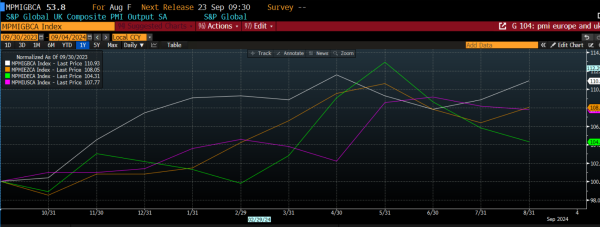More good news for the UK economy
The service sector PMI is another piece of good news for the UK economy. The all-important service sector PMI report for August rose to 53.7, up from 53.3 in July. This is the highest reading since April and bodes well for Q3 growth, after the manufacturing survey for August also bucked global trends for weaker manufacturing sentiment and posted a decent 52.5.
Service price inflation eases
S&P Global reported that business activity rose due to robust domestic demand and consumers’ willingness to spend, and an improving economic backdrop. BOE rate cuts also boosted sentiment, and inflation pressures eased. While wage pressures remain evident in the service sector, input cost inflation eased to its lowest level since 2021, while prices charged inflation (aka service price inflation) dropped to a 3.5 year low.
The biggest risk to the UK economy: a dour mood at Downing Street
Business activity expectations for the year ahead were also upbeat, however, some respondents said that uncertainty around tax increases ahead of the Autumn Budget weighed on their future expectations. Thus, the government needs to tread carefully around the messaging ahead of the Autumn budget. The real economy in the UK is doing well, and is better than its peers based on relative PMI performance, as you can see in the chart below. However, the new government’s doom and gloom about the budget, along with the prospect of tax rises ahead could lead to weaker sentiment and confidence down the line. Thus, the chancellor may change her tone in the coming weeks.
UK’s growth prospects beat rest of G7
The UK’s composite PMI reports for August, which includes the service sector and the manufacturing sector, are better than our G7 peers, including Germany, the Eurozone as a whole and the US, as you can see below.
Chart 1: Composite PMIs for US, Eurozone, Germany and the UK, normalized for 1 year to show how they move together.

Source: Bloomberg and XTB
From a market perspective, the stronger UK data is positive for the pound, which may embark on a short-term recovery if GBP/USD can break above $1.3150.
The FX view and why the pound could shine
The G10 FX space is being driven by short-term interest rate differential, which is positive for the pound. The market is pricing in more than 100 bps of rate cuts for the US between Sept and Dec this year, in the Eurozone the ECB is expected to cut rates by more than 60 bps and in the UK, the BOE is only expected to cut interest rates by 43bps between now and the end of the year. This gives the pound a decent rate differential vs. the USD and the euro, and is supportive of a decent recovery in GBP/USD from here. This pair could experience some volatility on the back of this week’s NFP report, a strong reading could lead to a recalibration of US rate cut expectations and a strengthening of the dollar. This may derail the pound’s recovery vs. the USD in the short term, however we think this will be temporary. Overall, we think that the pound can continue to rally, as the growth outlook and the interest rate differential remains supportive of further gains for sterling, even if there is some volatility in GBP/USD in the short term. A break above $1.3150 is positive for further gains back to the $1.3250 highs, while in the long term, we believe that if current interest rate trends persist, $1.35 is on the cards.